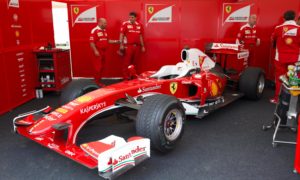Ferrari today played down the early pace that saw them top the Valencia timesheets on all three days of the first test of 2010. The Maranello squad are managing expectations that they have recovered some of the dominance they had at this point ten years ago, but nevertheless rumours are abounding about how fast they really are. What about all those famous variables that are at play in pre-season testing? How much of the speed has come from their fired-up drivers? And what does it mean for the rest of the teams?
The predominant and most influential school of thought suggests that Ferrari have actually produced a decent car in the F10. Pre-Valencia suggestions that there had been some dire aero tests, and that a B-spec car was already under construction, now seem to have been wide of the mark. Even if the F10 is not great and they have been fuelling it to the bare minimum, there seems to be little competitive point in Ferrari running on fumes now and producing a phantom pace. Further evidence came from McLaren’s Jenson Button, when he alluded to the fact that Ferrari had produced some slower times; perhaps, said the McLaren man, the red squad were even competitive with a bit more fuel in.
More plus points for Ferrari come in the shape of their driving line-up; Felipe Massa and Fernando Alonso excelled themselves in eastern Spain this week. For the Brazilian, the motivation comes from his absolute determination a) to prove he has lost none of his speed since his 170mph meeting with Rubens Barrichello’s rear spring last year and b) not to be immediately relegated to second Ferrari priority behind his new team-mate. For Alonso, it was enough simply to be in the team; even the Italian sense of humour, he gushed, was like being at home. He was at home physically as well as spiritually, of course, the mystical tenth of a second per lap that home fans are said to bring a driver perhaps playing their part. Jerez awaits Alonso, where any advantage he has will be compounded.
But there are also the doubters. Fuel load is set to be a much bigger factor in determining a car’s pace this season, considering the fuel tank is now twice the size it was last year. As such, performance discrepancies can be exaggerated. The rate of tyre degradation will also be affected by fuel load, and at a chilly Valencia, it will have been difficult to draw conclusions about tyre wear in high temperatures. Then there is the circuit Ricardo Tormo, an anodyne venue that does not seem to have any fast corners whatsoever. Renault’s Robert Kubica, among others, told the BBC that he was unimpressed with the track and the feedback it was giving his team.
So, as Ferrari seem to realise and are keen to remind everyone, one test does not make a summer. There are simply too many factors that they haven’t had a chance to test yet. Moreover, it is simply impossible to tell what the other teams are up to.
Another team that appears to have shone is Sauber. They could well be Brawn Mk II; a team abandoned by its fairy godmother but with the resources and the savoir-faire to be competitive. Mercedes look dangerous, like the dark horse of the group, biding their time and waiting to surprise. But as for the others, it is just very difficult to say. As the British media were at pains to point out this week, any performance gaps that do exist (say from Ferrari to McLaren) will result in an extremely steep development curve from the laggard. McLaren, as we found out last week, have safeguarded a large amount of cash in the event that their car needs to be a bit faster. But reports and opinions are mixed as to whether it is that much slower. Lewis Hamilton did say that he felt none of the problems he had done the year before.
So the conclusion is that at best an educated guess can be made about relative pace. Even inside the teams, they have only a rough idea about where they really are and how good their machine really is. And they are certainly not going to tell the media or the fans.








